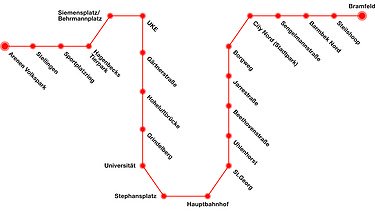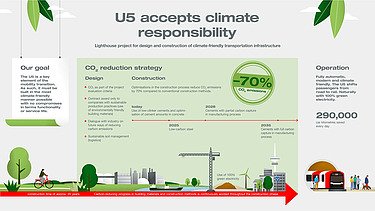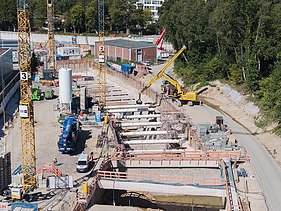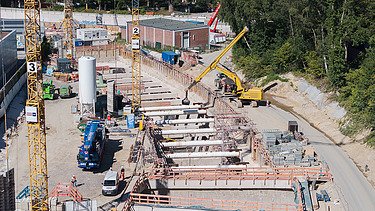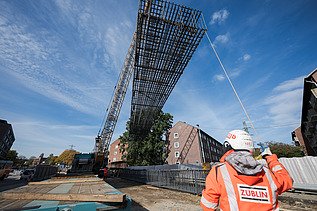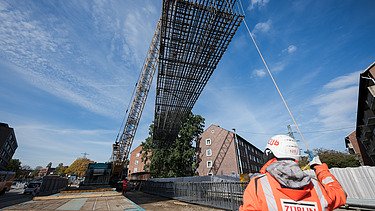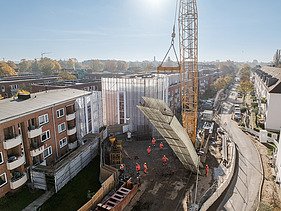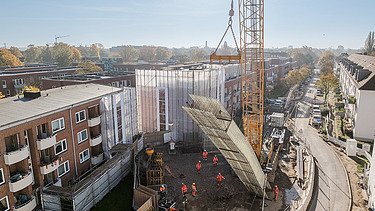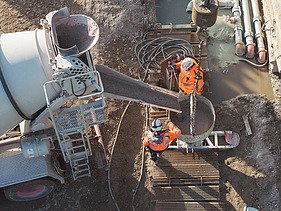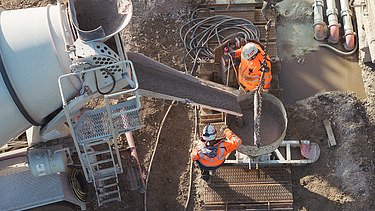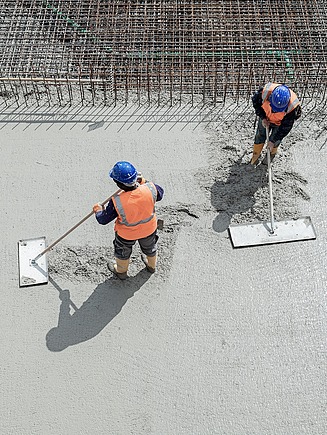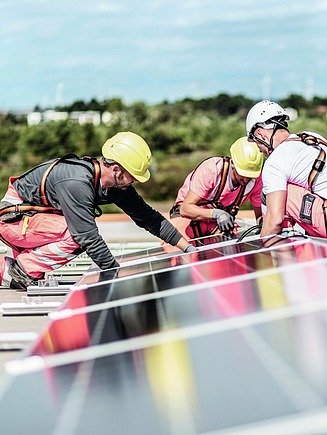Climate change mitigation given priority in construction of new U5 metro line in Hamburg
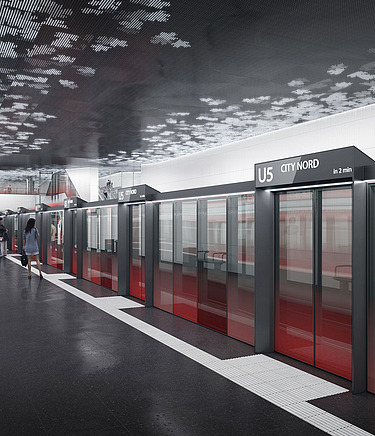
Focus on CO2 reduction: First section being realised for HOCHBAHN by ZÜBLIN and Wayss & Freytag
The construction of the new U5 metro line in Hamburg is setting new standards in climate protection. A central focus of the major infrastructure project commissioned by Hamburger Hochbahn AG (HOCHBAHN) is to avoid and reduce carbon dioxide emissions. ZÜBLIN, in a consortium with Wayss & Freytag, is realising the first construction section of the U5 metro line using low-carbon building materials, sustainable construction processes and carbon footprint monitoring throughout the project. The reduction strategy being pursued by the consortium for this large-scale project represents an unprecedented greenhouse gas (GHG) roadmap, the first of its kind in Germany. The climate-friendly realisation of the project over the next two decades should make it possible to reduce CO2 emissions during construction to 850,000 tonnes, 70% lower than the GHG load of approximately 2.7 million tonnes of CO2 from a project realised using conventional construction methods.
U5 metro line: fast and with zero emissions through Hamburg
The new U5 metro line across Hamburg is the largest public transport infrastructure project in Germany currently under construction. Hamburg’s fifth metro line will add a completely new east-west axis to HOCHBAHN’s transport network, linking the districts in the east (Bramfeld, Steilshoop) and the west (Stellingen and the Volkspark arenas) with the city centre (central railway station) over a distance of around 24 kilometres. The 22 new stations being built as part of the project will offer some 180,000 Hamburg residents new connections to the city’s metropolitan and suburban railway network. The use of pioneering technology will also make the U5 the first fully automatic metro line in Hamburg, enabling flexible and needs-based train scheduling. Once the overall project is completed (in 2040, according to current planning), HOCHBAHN estimates that around 270,000 passengers will use the new line every day to reach their destinations completely emission-free. This makes the U5 a key element of Hamburg’s mobility transition and an important part of the city’s goal of becoming climate neutral by the year 2050.
Start in the north-east: ZÜBLIN and Wayss & Freytag realising first section of U5
Construction work on this large-scale project has been in full swing in northeastern Hamburg since the official groundbreaking in autumn of 2022, with ZÜBLIN and Wayss & Freytag jointly working on the first construction section of the U5 between Bramfeld and City Nord (Stadtpark). A consortium of the two companies was awarded the contract for two staggered lots (Lots 1 and 2) by HOCHBAHN U5 Projekt GmbH. Four new underground stops (Bramfeld, Steilshoop, Barmbek Nord, City Nord) are being built on the approximately 5.8-kilometre section of the new line. As part of the first construction section, the existing Sengelmannstraße U1 station will also be converted into an above-ground transfer between the U1 and U5 lines. The consortium’s project team is building the section between City Nord and Sengelmannstraße (Lot 1) – including the new stations – using the cut-and-cover method. The approximately four-kilometre-long section to Bramfeld (Lot 2), to be built starting in 2027, will be excavated using a tunnel boring machine.
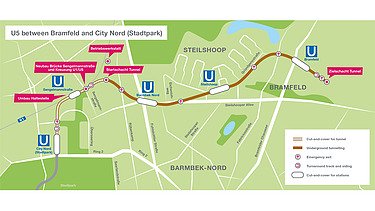
Material-saving planning for lower carbon emissions
An important factor in reducing harmful emissions is the construction method specified in the design. As a large proportion of the carbon emissions are attributable to the use of reinforced concrete, this important first step is all about minimising material use. In other words: less is more. The engineers at HOCHBAHN U5 Projekt GmbH therefore optimised the planning and design with a focus on material savings and low-carbon construction processes. Top priority, however, was given to avoiding compromises in terms of passenger comfort, functionality and service life.
Green electricity, sustainable logistics and climate-friendly building materials
Reducing the level of CO2 emissions during construction starts with the energy supply. The necessary electricity, for example for the tunnel boring machines, will be supplied entirely from renewable sources (green electricity). Soil management (excavation, transport, recycling) and logistics are also designed to be as sustainable and with as few emissions as possible.Despite the material-saving design, the material requirements for the project are immense. A total of around 4 million cubic metres of concrete and 600,000 tonnes of steel will be needed to build the new metro line in the coming years – vast quantities that could have an enormous potential impact in terms of harmful emissions. A big problem are the high-carbon manufacturing processes involved in producing the cement needed as a concrete binder, especially the clinker (clay and limestone) contained within the cement, as well as the primary steel from the coal-based blast furnace. The key to truly significant CO2 reductions therefore lies in the production of the concrete, cement and steel used. In order to achieve the GHG roadmap’s targets for the project, HOCHBAHN U5 Projekt GmbH plans to use the most climate-friendly building materials currently available on the market. But the company is also taking the concrete and steel manufacturers to task, focusing on technical progress in the course of the project by calling for the further development and introduction of sustainable production processes, for example.
The project’s carbon reduction plan is reflected in the day-to-day work of the ZÜBLIN and Wayss & Freytag teams. In the tendering process for building materials, for example, the GHG load is an additional award criterion that the manufacturers must verify through corresponding certification. To control and manage the reduction strategy, the actual carbon emissions of the construction work and of the materials used are documented and monitored in a continuous carbon footprint assessment performed for the duration of construction.
Cement composition a decisive factor for reducing CO2 in concrete
The consortium is focusing specifically on the use of low-carbon concrete during construction of the U5 metro line. The project team is using two key levers here to keep the GHG load to a minimum: reducing the amount of cement in the concrete and using concrete with a low clinker content. Cement is an important part of concrete, affecting curing time and stability. The key consideration for optimising the carbon footprint of the project is therefore to use as little cement as possible (but as much as is technically required). “We are pushing the limits of what is technically feasible here,” says Christian Hoffmann, ZÜBLIN project manager for Lot 1 of the first construction section – for example, by using concrete types with a reduced proportion of clinker in the cement. The clinker is replaced by other additives such as fly ash or ground granulated blast-furnace slag, which have similar chemical and physical properties as clinker but produce significantly fewer harmful emissions. Initial type testing of the building materials for their carbon reduction properties defines the concrete requirements for each possible use case during construction.
The clinker is replaced by other additives such as fly ash or ground granulated blast-furnace slag, which have similar chemical and physical properties as clinker but produce significantly fewer harmful emissions. Initial type testing of the building materials for their carbon reduction properties defines the concrete requirements for each possible use case during construction. Christian Hoffmann: “We’re actually carrying out development work here – that’s quite unique in Germany.” HOCHBAHN is also hoping that cements with partial (and later full) carbon capture in the manufacturing process can be used for the construction work by the end of the decade. The industry is currently working on solutions for sequestering and storing the carbon dioxide generated during production to prevent it from being released into the atmosphere in the first place.
Low-carbon steel grades for the new metro line
HOCHBAHN U5 Projekt GmbH is betting on the industry gradually switching to more climate-friendly production methods for steel as well. The consortium of ZÜBLIN and Wayss & Freytag will already be using low-carbon steel grades with the corresponding certification during construction of the U5 metro line in Lot 2 of the first construction section. The carbon footprint of the reinforcing steel used in the project is currently not allowed to exceed a maximum GHG load of 500 kg of CO2 per tonne. Compared to reinforcing steel produced conventionally in blast furnaces, however, this will reduce steel-related carbon emissions by more than half. This reduction is made possible through the use of green electricity during production and by using recycled or melted scrap metal from electric arc furnaces. The steel supplier must provide evidence of this reduction: “What we need here are environmental product declarations, or EPDs,” says Yves Grebing, ZÜBLIN overall project manager for Lot 2. And that’s not all: the transport routes must be made transparent as well. “We also have to prove that the low-carbon steel actually ends up on the construction site,” Grebing explains. The process, which has the potential to become a model for the future, puts the U5 in a pioneering position in Germany. HOCHBAHN is also firmly committed to making further progress on sustainability in steel production in the future. In the long term, consistent climate change mitigation in the steel industry means switching from coal-based blast furnaces to primary steel production using green hydrogen (direct reduction).
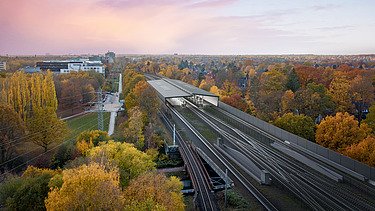
Factsheet:

U5 Hamburg

